Financial Transition - Doc
Added on 2020-04-21
82 Pages20929 Words35 Views
Running head: FINANCIAL TRANSITION
Financing Transition: The role of Wind and Solar Energy in the Swiss Energy Strategy
Name of the Student:
Name of the University:
Author’s Note:
Financing Transition: The role of Wind and Solar Energy in the Swiss Energy Strategy
Name of the Student:
Name of the University:
Author’s Note:
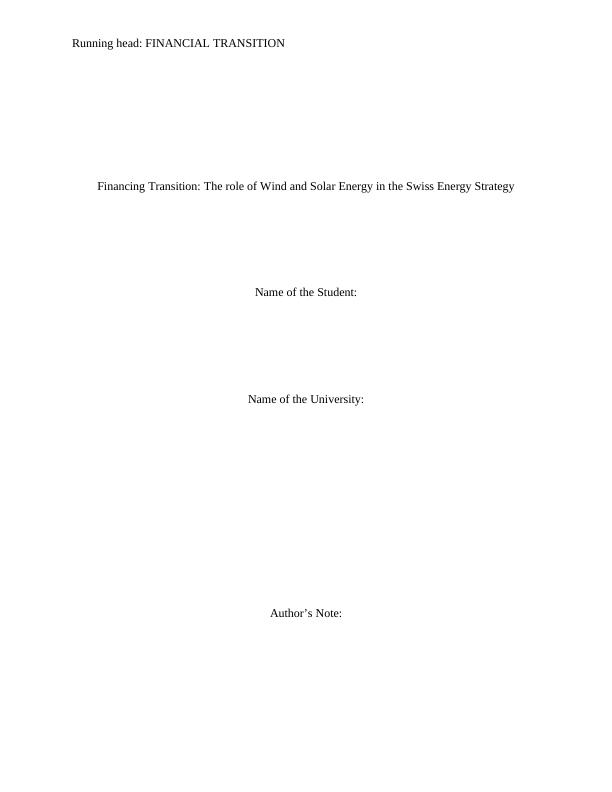
1FINANCIAL TRANSITION
Abstract
This paper has been constructed in order to have an idea about the impact of role wind and solar
energy in Switzerland in accordance to the Swiss Energy Strategy 2050. The paper has explained
the background of the paper and accordingly the electricity market in Switzerland and their
neighbouring countries. The problem statement has even explained the areas and the factors that
have impact the electricity market in the concerned region. The research objectives and aims
have explained the areas where the analysis would be undertaken and the processes that would
be used in order to complete the paper in a precise manner. The literature review has provided
the solar and wind power plant sources and the electricity transmission system in Switzerland.
The pillars that are related to the Swiss Energy Strategy have even been addressed and
accordingly the process of electricity flow have been determined. The process of data collection
have been addressed and accordingly assessment of the data have been attained with the help of
which the paper has been able to answer the issues related to the flow of electricity, the price,
demand and supply of the solar, wind and hydro generated electricity in Switzerland and their
neighbouring countries.
Abstract
This paper has been constructed in order to have an idea about the impact of role wind and solar
energy in Switzerland in accordance to the Swiss Energy Strategy 2050. The paper has explained
the background of the paper and accordingly the electricity market in Switzerland and their
neighbouring countries. The problem statement has even explained the areas and the factors that
have impact the electricity market in the concerned region. The research objectives and aims
have explained the areas where the analysis would be undertaken and the processes that would
be used in order to complete the paper in a precise manner. The literature review has provided
the solar and wind power plant sources and the electricity transmission system in Switzerland.
The pillars that are related to the Swiss Energy Strategy have even been addressed and
accordingly the process of electricity flow have been determined. The process of data collection
have been addressed and accordingly assessment of the data have been attained with the help of
which the paper has been able to answer the issues related to the flow of electricity, the price,
demand and supply of the solar, wind and hydro generated electricity in Switzerland and their
neighbouring countries.
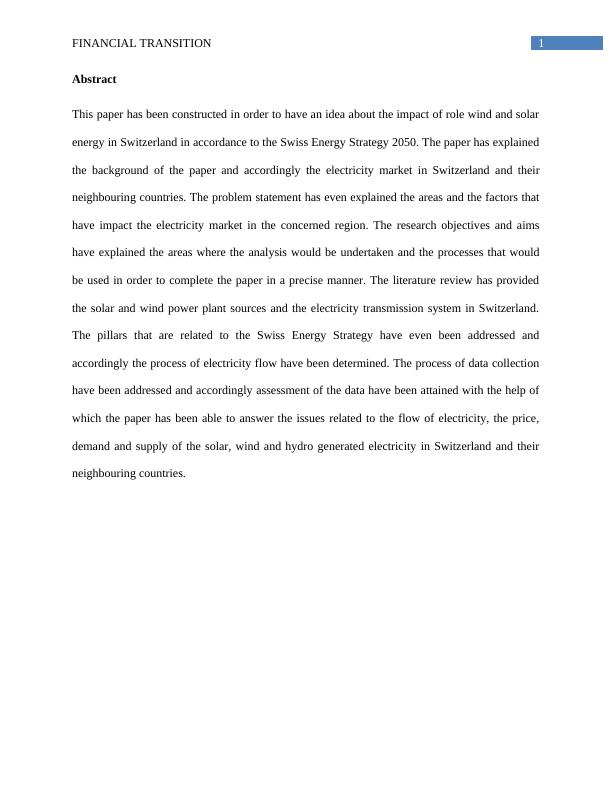
2FINANCIAL TRANSITION
Table of Contents
Chapter 1: Introduction....................................................................................................................6
1.1 Background of the Study.......................................................................................................6
1.2 Problem Statement...............................................................................................................11
1.3 Research Aims and Objectives............................................................................................11
1.4 Research Questions..............................................................................................................12
1.5 Summary..............................................................................................................................12
Chapter 2: Literature Review.........................................................................................................13
2.1 Introduction..........................................................................................................................13
2.2 Wind energy and solar energy.............................................................................................13
2.3The role of the Swiss Transmission System.........................................................................14
2.4Energy Strategy 2050...........................................................................................................14
2.5The three pillars of Energy Strategy 2050............................................................................15
2.5.1 Saving energy and enhancing efficiency......................................................................15
2.5.2 Promoting renewable energies......................................................................................15
2.5.3 Withdrawal from nuclear power...................................................................................15
2.6DETC Strategy......................................................................................................................16
2.6.1 Fall in the consumption of resources and energy.........................................................17
2.6.2 Coordination of transport planning and the spatial development.................................18
2.6.3 Digitisation in Switzerland...........................................................................................19
Table of Contents
Chapter 1: Introduction....................................................................................................................6
1.1 Background of the Study.......................................................................................................6
1.2 Problem Statement...............................................................................................................11
1.3 Research Aims and Objectives............................................................................................11
1.4 Research Questions..............................................................................................................12
1.5 Summary..............................................................................................................................12
Chapter 2: Literature Review.........................................................................................................13
2.1 Introduction..........................................................................................................................13
2.2 Wind energy and solar energy.............................................................................................13
2.3The role of the Swiss Transmission System.........................................................................14
2.4Energy Strategy 2050...........................................................................................................14
2.5The three pillars of Energy Strategy 2050............................................................................15
2.5.1 Saving energy and enhancing efficiency......................................................................15
2.5.2 Promoting renewable energies......................................................................................15
2.5.3 Withdrawal from nuclear power...................................................................................15
2.6DETC Strategy......................................................................................................................16
2.6.1 Fall in the consumption of resources and energy.........................................................17
2.6.2 Coordination of transport planning and the spatial development.................................18
2.6.3 Digitisation in Switzerland...........................................................................................19

3FINANCIAL TRANSITION
2.7Swiss Power market..............................................................................................................20
2.7.1 Legal Responsibility.....................................................................................................20
2.7.2 Liberalisation of the Swiss Power market....................................................................20
2.7.3 Structure of the Swiss Power Market...........................................................................21
2.7.4 Measures relating to energy efficiency.........................................................................23
2.8Current measurements in determining the cost-effective savings........................................24
2.9Financing approaches to the solar and wind energy.............................................................24
2.9.1 Private Sector................................................................................................................25
2.9.2 Public Sector.................................................................................................................26
2.9.3 Investment Sources.......................................................................................................26
2.10Fiscal preferential treatment...............................................................................................27
2.10.1 Renewable energy sources..........................................................................................27
2.11Need for energy..................................................................................................................27
2.12Set of measures for Energy Strategy..................................................................................28
2.12.1 Measures for raising the effectiveness of energy.......................................................29
Chapter 3: Research Methodology................................................................................................31
3.1 Introduction..........................................................................................................................31
3.2 Purpose and significance of the research.............................................................................31
3.3 Research Tools.....................................................................................................................32
3.4Research Approach...............................................................................................................32
2.7Swiss Power market..............................................................................................................20
2.7.1 Legal Responsibility.....................................................................................................20
2.7.2 Liberalisation of the Swiss Power market....................................................................20
2.7.3 Structure of the Swiss Power Market...........................................................................21
2.7.4 Measures relating to energy efficiency.........................................................................23
2.8Current measurements in determining the cost-effective savings........................................24
2.9Financing approaches to the solar and wind energy.............................................................24
2.9.1 Private Sector................................................................................................................25
2.9.2 Public Sector.................................................................................................................26
2.9.3 Investment Sources.......................................................................................................26
2.10Fiscal preferential treatment...............................................................................................27
2.10.1 Renewable energy sources..........................................................................................27
2.11Need for energy..................................................................................................................27
2.12Set of measures for Energy Strategy..................................................................................28
2.12.1 Measures for raising the effectiveness of energy.......................................................29
Chapter 3: Research Methodology................................................................................................31
3.1 Introduction..........................................................................................................................31
3.2 Purpose and significance of the research.............................................................................31
3.3 Research Tools.....................................................................................................................32
3.4Research Approach...............................................................................................................32
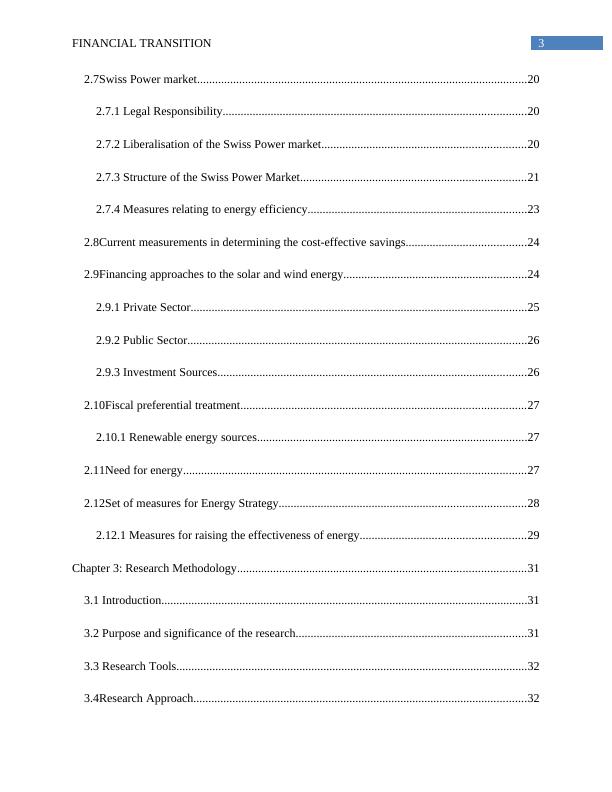
4FINANCIAL TRANSITION
3.5Research Design...................................................................................................................33
3.6 Sample and Sample Size......................................................................................................34
3.7 Primary data collection........................................................................................................35
3.8 Secondary information accumulation..................................................................................35
3.9 Rationale for the decision of test.........................................................................................36
3.10 Research Outline................................................................................................................36
3.11 Research Bias.....................................................................................................................37
3.12 Data validation and reliability...........................................................................................37
3.13 Ethics.................................................................................................................................37
Chapter 4: Data Analysis and Discussion......................................................................................40
4.1 Introduction..........................................................................................................................40
4.2 Swissmod.............................................................................................................................40
4.3 Data......................................................................................................................................41
4.4 Scenarios..............................................................................................................................43
4.4.1 Base case.......................................................................................................................43
4.4.2 Swiss Delay..................................................................................................................43
4.4.3 European Delay............................................................................................................43
4.4.4 Full Delay.....................................................................................................................43
4.5 Model Assumptions and Limitations...................................................................................43
4.6 Results..................................................................................................................................45
3.5Research Design...................................................................................................................33
3.6 Sample and Sample Size......................................................................................................34
3.7 Primary data collection........................................................................................................35
3.8 Secondary information accumulation..................................................................................35
3.9 Rationale for the decision of test.........................................................................................36
3.10 Research Outline................................................................................................................36
3.11 Research Bias.....................................................................................................................37
3.12 Data validation and reliability...........................................................................................37
3.13 Ethics.................................................................................................................................37
Chapter 4: Data Analysis and Discussion......................................................................................40
4.1 Introduction..........................................................................................................................40
4.2 Swissmod.............................................................................................................................40
4.3 Data......................................................................................................................................41
4.4 Scenarios..............................................................................................................................43
4.4.1 Base case.......................................................................................................................43
4.4.2 Swiss Delay..................................................................................................................43
4.4.3 European Delay............................................................................................................43
4.4.4 Full Delay.....................................................................................................................43
4.5 Model Assumptions and Limitations...................................................................................43
4.6 Results..................................................................................................................................45
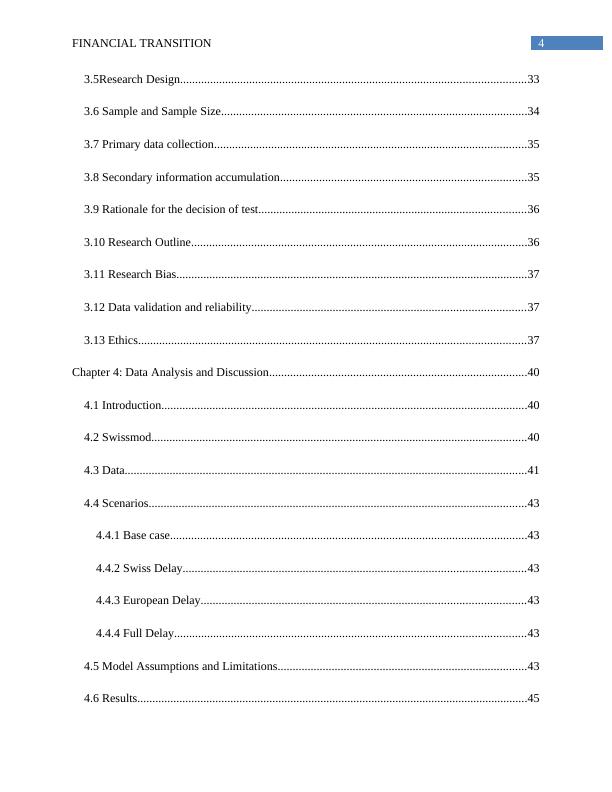
5FINANCIAL TRANSITION
4.6.1 Base Case Development till 2050.................................................................................45
4.6.2 Overview on the Delay Scenario..................................................................................54
4.7 Detailed Impacts of the Network Extension Delays............................................................57
4.7.1 National Price Impacts and the Winner and the Loser of the Problem........................57
4.8 Impact of Swiss Electricity market and the Energy Transition...........................................59
Chapter 5: Conclusion, Recommendation and Future Work.........................................................62
5.1 Conclusion...........................................................................................................................62
5.2 Addressing the aims and objectives.....................................................................................65
5.3 Recommendation.................................................................................................................66
5.4 Further Research Work........................................................................................................66
Reference List................................................................................................................................67
Bibliography..................................................................................................................................75
Appendix........................................................................................................................................79
4.6.1 Base Case Development till 2050.................................................................................45
4.6.2 Overview on the Delay Scenario..................................................................................54
4.7 Detailed Impacts of the Network Extension Delays............................................................57
4.7.1 National Price Impacts and the Winner and the Loser of the Problem........................57
4.8 Impact of Swiss Electricity market and the Energy Transition...........................................59
Chapter 5: Conclusion, Recommendation and Future Work.........................................................62
5.1 Conclusion...........................................................................................................................62
5.2 Addressing the aims and objectives.....................................................................................65
5.3 Recommendation.................................................................................................................66
5.4 Further Research Work........................................................................................................66
Reference List................................................................................................................................67
Bibliography..................................................................................................................................75
Appendix........................................................................................................................................79
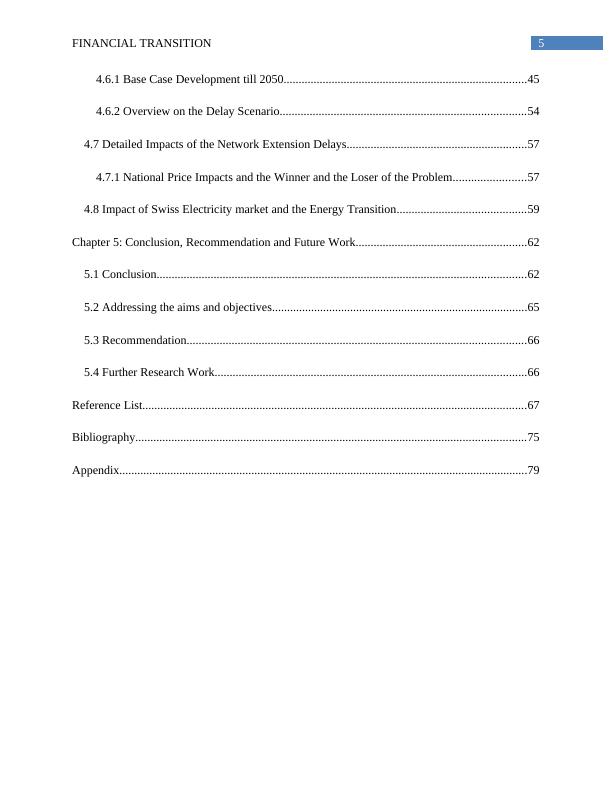
6FINANCIAL TRANSITION
Chapter 1: Introduction
In the modern economy there has been development of various new and improved
technologies with the help of which the countries and the organizations operating within them
have been able to develop their business. One of the essential elements that have been influential
for the development of the economy and the nations has been use of electricity. Electricity is
generated from various non-renewable resources like coal but with the advent of time there has
been an observation that human beings look to generate electricity from renewable sources like
water and solar energy (Baker 2015).
With the advent of time, there have been various assessments and analysis with the help
of which the electricity system of any country has been discovered and thereby the costs
associated with it and the potentials in accordance to the socio-economic environment can be
gathered (Abolhosseini and Heshmati 2014). This paper would even examine the supply mix and
the costs along with the carbon emissions and the supply flexibility.
This paper will therefore look to assess the role of renewable energies (wind and solar) in
the energy market of Switzerland 2050 and would look to assess the means to finance such
energies. The input projections and the outcome of various studies have been compared. The
paper would even explain the modelling structure of the papers along with their projections.
1.1 Background of the Study
This paper has chosen the “Swiss Energy Strategy 2050” and the function of renewable
energies and the means to finance it. The studies that are considered are published within the
time span of the year 2011 to 2013, which is after the adverse accident in the nuclear power plant
of Fukushima in Japan in the year 2011 and the succeeding decisions of the “Swiss Federal
Council” to progressively segment the nuclear power in the year May 2011. In the present time,
Chapter 1: Introduction
In the modern economy there has been development of various new and improved
technologies with the help of which the countries and the organizations operating within them
have been able to develop their business. One of the essential elements that have been influential
for the development of the economy and the nations has been use of electricity. Electricity is
generated from various non-renewable resources like coal but with the advent of time there has
been an observation that human beings look to generate electricity from renewable sources like
water and solar energy (Baker 2015).
With the advent of time, there have been various assessments and analysis with the help
of which the electricity system of any country has been discovered and thereby the costs
associated with it and the potentials in accordance to the socio-economic environment can be
gathered (Abolhosseini and Heshmati 2014). This paper would even examine the supply mix and
the costs along with the carbon emissions and the supply flexibility.
This paper will therefore look to assess the role of renewable energies (wind and solar) in
the energy market of Switzerland 2050 and would look to assess the means to finance such
energies. The input projections and the outcome of various studies have been compared. The
paper would even explain the modelling structure of the papers along with their projections.
1.1 Background of the Study
This paper has chosen the “Swiss Energy Strategy 2050” and the function of renewable
energies and the means to finance it. The studies that are considered are published within the
time span of the year 2011 to 2013, which is after the adverse accident in the nuclear power plant
of Fukushima in Japan in the year 2011 and the succeeding decisions of the “Swiss Federal
Council” to progressively segment the nuclear power in the year May 2011. In the present time,
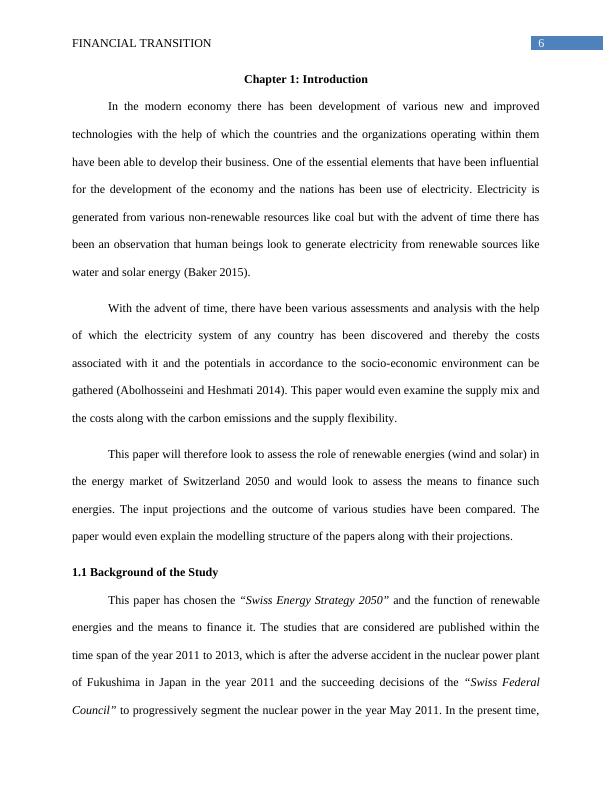
7FINANCIAL TRANSITION
the generation of electricity in Switzerland is dependent hugely on the nuclear power with the
present supply mixes of Switzerland and the countries that are neighbouring them.
The fundamental aim and goal of the “Energy Strategy 2050” with respect to the “Swiss
Federal Council” is supply of energy that permits them with reasonable prices and an extent of
security of the supply with respect to the current period along with the fall in the emission of
CO2 with respect to today (Nie et al. 2016). In accordance to the neighbouring countries, there
has been an observation that Switzerland has the minimum number of shares of the generation of
electricity with the help of the fossil fuels and from other sources that are renewable in nature
other than hydro power. Subsequently, the key focus in the present thesis is on the supply side
for the two largely undiscovered options to accomplish even partially with respect to the goals of
energy transition.
The main objective of the thesis has been to assess the electricity system and therefore
the paper that concentrates on the vaster economy and the overall energy system process of
Switzerland have not been taken into consideration (Nanda, Younge and Fleming 2014). The
assessment looks to assist the decision makers in evaluating the extent of options that have been
exhibited by various aspects of demand and supply of electricity and thereby looks to assist the
industry professionals and the researchers in order to enhance the case development and the
transparency of the framework.
For every scenario, the anticipated socio-economic restriction situations and the disclosed
key drivers are being assessed. A comparison of the parameters for instance potentials and costs
of the technology and the anticipated effective gains if it is disclosed is understood. A disclosure
on the explanations of the utilised modelling structures, their scope and the assumptions that is
implicit in nature (Shen and Luo 2015). The key groups of outcomes are assessed and compared
the generation of electricity in Switzerland is dependent hugely on the nuclear power with the
present supply mixes of Switzerland and the countries that are neighbouring them.
The fundamental aim and goal of the “Energy Strategy 2050” with respect to the “Swiss
Federal Council” is supply of energy that permits them with reasonable prices and an extent of
security of the supply with respect to the current period along with the fall in the emission of
CO2 with respect to today (Nie et al. 2016). In accordance to the neighbouring countries, there
has been an observation that Switzerland has the minimum number of shares of the generation of
electricity with the help of the fossil fuels and from other sources that are renewable in nature
other than hydro power. Subsequently, the key focus in the present thesis is on the supply side
for the two largely undiscovered options to accomplish even partially with respect to the goals of
energy transition.
The main objective of the thesis has been to assess the electricity system and therefore
the paper that concentrates on the vaster economy and the overall energy system process of
Switzerland have not been taken into consideration (Nanda, Younge and Fleming 2014). The
assessment looks to assist the decision makers in evaluating the extent of options that have been
exhibited by various aspects of demand and supply of electricity and thereby looks to assist the
industry professionals and the researchers in order to enhance the case development and the
transparency of the framework.
For every scenario, the anticipated socio-economic restriction situations and the disclosed
key drivers are being assessed. A comparison of the parameters for instance potentials and costs
of the technology and the anticipated effective gains if it is disclosed is understood. A disclosure
on the explanations of the utilised modelling structures, their scope and the assumptions that is
implicit in nature (Shen and Luo 2015). The key groups of outcomes are assessed and compared
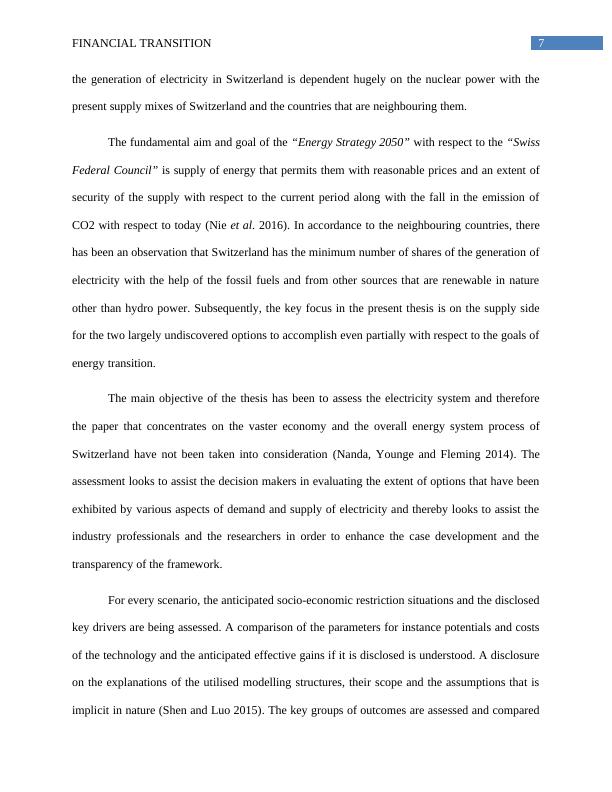
End of preview
Want to access all the pages? Upload your documents or become a member.
Related Documents
Feasibility Study of Solar Energy Infrastructure in Australialg...
|34
|13206
|39
Paper on Methods of Solar Photovoltaic Cellslg...
|45
|10576
|59
Development of Sustainable Marketing Communications in the Energy Industry of an Emerging Economy: A Case Study of Renewable Energy in Nigerialg...
|60
|15320
|133
Challenges and Development of Nuclear Energy in Australialg...
|43
|9835
|154
Wave Energy vs Other Renewable Energy Sources Research 2022lg...
|45
|11309
|12
Energy and Efficiency: Strategies for Clean Energy Adoptionlg...
|15
|785
|82
